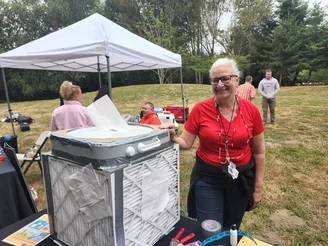I have enjoyed the warm summer here in Humboldt County, and I’ve been spending time in my sunny backyard with my family, getting my annual reminder that sunscreen is not magical and needs reapplication. United Indian Health Services (UIHS) has even hosted some outdoor community events at our clinics throughout the region, some for the first time in three years. Seeing old friends, clients and coworkers in person has been as soothing and needed as those precious sunny summer days are to my mental health.
That said, this is your monthly COVID-19 column, and while the “rules” have changed recently, at least according to the CDC, the actual situation across the country still suggests a need for proactive steps, or at least that I inform you of the current state of affairs.
Let’s start with those CDC guidance changes. The CDC has “streamlined” the COVID-19 guidance, and has removed social distancing recommendations, quarantine and “test-to-stay” for school. It is also no longer required to mask on public transit (but it is recommended) or have proof of a vaccination or a negative test before, during or after travel.
The logic behind this seems to be twofold. First is the idea of “meeting people where they are,” and not trying to force or demand action from the public, since you may have noticed that was slightly divisive and didn’t work as intended. Second is the acknowledgment that COVID-19 exposure is happening regularly, and quarantining after exposure is, unfortunately, no longer a realistic response with so many cases still going around. COVID-19 is now posing less risk of “medically significant” infections, so the guidance is simplified to “stay current with your vaccines and stay home if you are sick.”
Confirmed cases in California have been trending downward for a month, which is great. Both Humboldt and Del Norte Counties are “low” or “in the green” as far as transmission (cases and hospitalizations). Unfortunately, there are still 8,000 cases daily (in California), and experts suggest the true number could be 6-7 times higher. Summer is also drawing to a close, and the colder weather will draw all of us indoors, which has lead to a troubling surge in COVID-19 deaths the past two years, while over 500 Americans still die daily of COVID-19.
None of this is to make you despair — the situation has been improving slowly, and there are mitigation efforts you can take to protect yourself and your community. Check with the Centers for Disease Control and Prevention “COVID-19 by County” page to see what level of caution you should take when out and about, or even when traveling to another area. Being ready for the unexpected helps me feel better when I am traveling — emergency kit for the car, first aid kit, disinfecting wipes, masks, hand sanitizer and antigen test kits are the new normal.
Last month I introduced you to Corsi-Rosenthal boxes, and I have been building my own and teaching classes on them in the community. These filters will remove well over 90 percent of virus and bacteria particles in the air (also wildfire smoke!) and are incredibly easy to make. If you are worried about the air quality in a shared space, I encourage you to build and install a Corsi-Rosenthal box. They are great in school classrooms, offices and retail shops, and have a meaningful impact on reducing the spread of COVID-19.
Forget COVID-19 for a minute. Your grandmother was right — if you’re sick, stay home (and get tested). If you do get infected with COVID-19, you still need to isolate for five days whether you have symptoms or not. COVID-19 antigen (at home, rapid) tests are available and very helpful to use if you are experiencing symptoms — even if you think it’s “just a cold” or “boy, my allergies are really acting up”, or “wow, this smoke is really making my throat feel scratchy.” And don’t forget to wash those hands!
Regardless of when you end isolation, avoid being around people who are more likely to get very sick from COVID-19 until at least day 11, wear a high-quality mask around people, and do not go places where you are unable to wear a mask, including public transportation and travel settings.
Masking remains important for those who aren’t infected as well. As I mentioned last month, the BA.5 variant has become the dominant strain in most areas, and it remains infectious for the vaccinated and previously-infected alike. This is troubling because of what is becoming known as “long COVID.” While risks of severe infection, hospitalization and death have decreased, incidents of long COVID have continued for some people infected with the regular version of COVID.
Long COVID is still not well understood but is essentially a cluster of late onset health symptoms brought on by COVID-19 infection. One of the more common symptoms associated with long COVID is brain fog. I don’t know about anyone else, but I don’t need any additional brain fog in my life. Some other symptoms include tiredness, fatigue, fever, difficulty breathing, headache, difficulty sleeping, joint pain, depression, and anxiety. No. Thank. You. Very much.
Fall approaches, and the rules are becoming recommendations. Use your freedom to make healthy choices, and listen to your grandmother.
###
Michelle Lewis-Lusso (she/her) is an Infection Prevention and Control nurse at United Indian Health Services, serving the 11,000+ clients and staff at their six area clinics. She’s not your grandma, but also thinks you should cover your mouth when you cough.

CLICK TO MANAGE